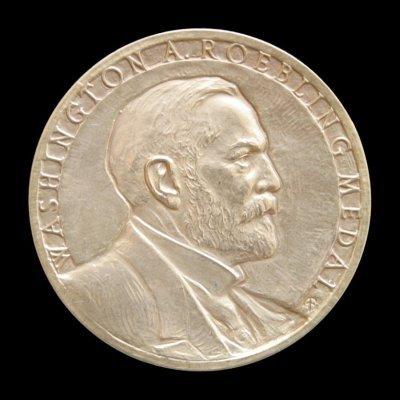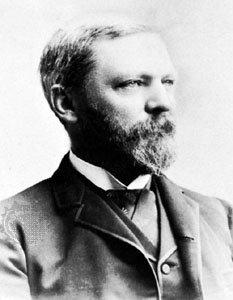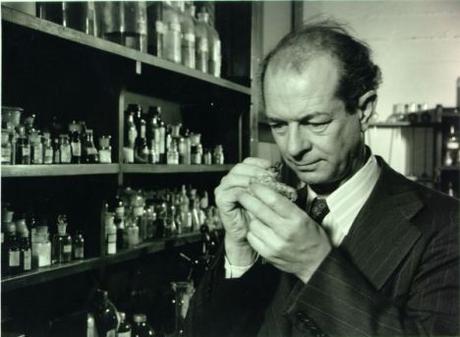 The Washington A. Roebling Medal, presented to Linus Pauling in 1967
The Washington A. Roebling Medal, presented to Linus Pauling in 1967“I remember that when my wife and I visited Dr. Albert Schweitzer in Lambarene a number of years ago, I suggested to him that his principle of reverence for life ought to be extended to include minerals, and perhaps could be named the principle of reverence for the world.”
-Linus Pauling, 1967
In November 1967, Linus Pauling traveled to New Orleans, Louisiana to attend the annual meeting of the Geological Society of America. The society was composed of six sections including the Mineralogical Society of America, which had invited Pauling to receive its most prestigious award: the Washington A. Roebling Medal.
Born in 1837, Washington Roebling was a civil engineer who worked primarily on suspension bridges and who, most famously, oversaw the construction of the Brooklyn Bridge in New York City. His father John A. Roebling, also a renowned civil engineer, had initially designed the Brooklyn Bridge but died of tetanus before construction began. It was at that point that Washington Roebling assumed leadership of the project as well as the family business, John A. Roebling’s Sons Company. He continued in this capacity until his passing in 1926.
 Washington Roebling. Credit: Rutgers University Library, Special Collections and Archives
Washington Roebling. Credit: Rutgers University Library, Special Collections and ArchivesIn addition to his achievements as an engineer, Roebling was also an avid mineral collector who scouted out and saved more than 16,000 specimens during his lifetime. After his death the collection was donated to the Smithsonian Institution, at which point it was noted that, of the 1,500 mineral species then known, only fifteen were not represented in Roebling’s assemblage. As a natural outgrowth of his hobby, Roebling was also an active member of the Mineralogical Society of America, assuming the position of vice president late in life.
In 1937 the Mineralogical Society of America created the Roebling Medal to honor the memory of one their highest profile members. The award was meant to be the most prestigious decoration offered by the society, as granted to an individual who had made “scientific publications of outstanding original research in mineralogy.” Nominations could be put forth for any qualified individual, whether or not they were strictly a mineralogist. For several years prior to issuing the award for the first time, the society earmarked a small percentage of their members’ annual dues to fund the medal, which was cast from 14 karat gold and bore an image of its namesake.
At the 1967 ceremony in New Orleans, Pauling was introduced by Jose D. H. Donnay, a mineralogy professor at Johns Hopkins University. A charming speaker, Donnay reflected on Pauling’s humble origins, his academic and professional accolades, his extensive and varied research interests, and the achievements that had resulted in this honor. As Donnay noted in his enthusiastic remarks
Let me, at least, remind you of the fields of endeavor in which [Pauling] himself admits taking an interest: crystal structures, molecular structures, line spectra, quantum chemistry, molecular rotation in crystals, ionic radii, theory of stability of complex crystals, proteins and helices, in short the vast subject of the chemical bond; turning toward biology and medicine: the relation between disease and molecular abnormality, immunochemistry, sickle-cell anemia; in other fields, structural problems of metals and alloys, ferromagnetism. Some people have asked me, ‘Why give Pauling one more medal? Will not our modest homage look like an anti-climax?’ [To which I would answer]…there is not a single mineralogical medal in his present-day medalary…our own profession, which owes him so much, cannot tarry, cannot be ungrateful any longer: it is high time we jumped on the band wagon!
Donnay drafted his speech months before the Louisiana meeting and had asked Pauling to proofread it. The only edits that he suggested be made were mention of his newly published book, The Chemical Bond, as well as his receipt of an overseas addition to the medalary: the Correspondant por a Mineralogie award, granted by the French Academy of Science in 1948.
In his acceptance address, Pauling reflected several personal and professional outcomes of his life-long love affair with mineralogy. He recalled in particular that his interest in the study of rocks and minerals had reached an early crescendo some fifty years earlier when, as a young college student, he initiated a systematic, year-long effort to collect specimens native to the Willamette Valley of Oregon. Unfortunately for him, Pauling was not well-equipped to pursue this task as he was limited by his only mode of transportation: a bicycle.
While this initial quest proved unsuccessful, Pauling’s enthusiasm did not wane but rather took on a more academic form, including mining geology courses at Oregon Agricultural College, complete with lab work on blowpipe analysis and fire assay.
 Linus Pauling, 1947
Linus Pauling, 1947Pauling next noted that it was a Caltech scientist, C. Lalor Burdick, who was the first to correctly determine the molecular structure of a mineral, chalcopyrite. Completed while Pauling himself was still in his first year at OAC, this discovery and others like it inspired Pauling to begin his own research on the structure of molybdenite once he had arrived at Caltech to begin graduate studies. Co-published with his mentor, Roscoe Gilkey Dickinson, the molybdenite project was just the beginning of a remarkable phase of productivity and insight. Within the next thirteen years, Pauling investigated sixty-three other minerals using x-ray diffraction techniques, publishing structures for over half of them.
Later on, Pauling encouraged a student to dig back into the past and review Burdick’s original work, an examination that yielded fruit. As he noted in his talk,
I suggested to one of my graduate students, L. O. Brockway, that he carry out a reinvestigation of chalcopyrite in order to determine the parameter with greater accuracy. He found Burdick had made an error, and had reported a wrong distribution of copper and iron atoms over the zinc positions in sphelerite. The correct structure was reported by Brockway and me in 1933.
Pauling likewise made mention of a collection of specimens that Robert Oppenheimer gave to him after a meeting in 1927. Though offered mostly as a gesture of friendship, the collection also proved useful to Pauling’s research, and he continued to study the specimens until the late 1930s, when his interest shifted towards the interactions between hemoglobin and oxygen. Though biological topics would dominate much of his work going forward, Pauling stressed that “I continue to find pleasure in looking at minerals, and thinking about their structures.”
Two years after receiving the Roebling Medal, Pauling was invited back by the society to give a speech titled “Crystallography and Chemical Bonding of Sulfides,” which was published in the Fiftieth Anniversary Symposium volume of the Mineralogical Society of America Journal. Pauling remained a society fellow for life and received a certificate recognizing his contributions to the group in 1994, not long before he passed away.
